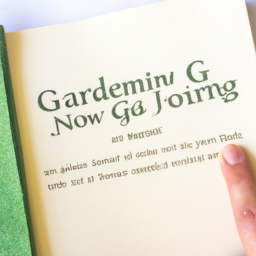How To Keep A Gardening Journal
How To Keep A Gardening Journal
Introduction
Gardening has become increasingly popular over the years, and for good reason! Not only is it a way to show off your unique creativity and style, but it can also be a great form of exercise, a way to get out in nature, and a fantastic way to enjoy the fruits of your labor year-round. It's no surprise then that the old adage If you're going to do something, do it right! applies to gardening as well. Keeping a gardening journal is an essential part of gardening, providing an easy way to learn from successes and failures, improve the health and productivity of your garden, and enjoy your efforts even more. Let's take a look at how to keep a gardening journal to get the most out of your gardening experiences.
What to Record
Overview
The key to keeping a successful gardening journal is to capture detailed information about your garden, so that you can easily track your progress and refer back to certain points in time. You will want to make sure to write down anything and everything you can think of that's related to the health and fertility of the soil, the growth of the plants, pest problems you might be confrontinganything that you might want to remember for future reference.
Garden Layout and Design
Keeping a detailed account of how your garden is laid out is important because it allows you to see the progress you're making as the garden develops. Make sure to sketch out the exact layout of each bed and label species, both of which will be necessary when tracking the growth of individual plants. You'll also want to take notes on any design choices you've made, such as where you chose to put certain plants or what type of decorations you used in the garden to make it more aesthetically pleasing.
Crop Planting and Care
For each crop you plant, you'll want to write down the plants' variety, sowing date, and any special planting instructions you used. You'll also want to keep track of when you transplanted them, harvested them, and, if necessary, when you composted or mulched them. Additionally, you should carefully track any structural changes you make to the plants, such as trellising or pruning, and make note of any other care instructions you found necessary.
Weather and Soil Conditions
Taking detailed notes on the weather and soil conditions you encounter throughout the year helps you to get a better understanding of how your crops responded to the climate. Be sure to note the temperature, humidity, and rainfall for each day, and check your soil's moisture and fertility levels often so that you can accurately record them as well.
Pest and Disease Prevention
If possible, try to keep track of any pest or disease problems you have in the garden, including what type of pests and parasites you're dealing with and any methods you've used to get rid of them. This can be incredibly helpful if you begin to notice recurring issues with certain types of crops, as it can then help guide you in understanding what kind of control treatments may be necessary to keep them in check.
Garden Maintenance
Put down in your journal any maintenance tasks you've done in the garden, such as trimming, weeding, and fertilizing. That way, you can look back and determine what worked and what didn't and adjust your regular maintenance routine accordingly.
Harvest Records and Yields
Keeping a record of how much of each crop you harvested is incredibly useful, both when it comes to understanding the growth of your crops and when it comes to planning for the future. Not only should you record how much you harvest each year, but you should also keep track of how long it takes for each crop to mature and how much you end up selling or donating. This information is invaluable when it comes to optimizing your garden for maximum efficiency and yield.
In Summary
A gardening journal can be an immensely useful tool for any gardener who wants to track their successes and failures and learn from them. Make sure you capture information about your garden layout and design, crop planting and care, weather and soil conditions, pest and disease prevention, regular maintenance tasks, and your harvest records and yields. With this data, you can determine which crops work best in your environment, when to start planting, what pest and disease control treatments may be necessary, and much more.
Keeping a gardening journal is the best way to get the most out of your gardening experiences. It's an essential part of any gardening routine, and with a bit of effort on your part, you'll be able to use it to maximize the productivity and beauty of your garden!

Previous Page
Next Page
